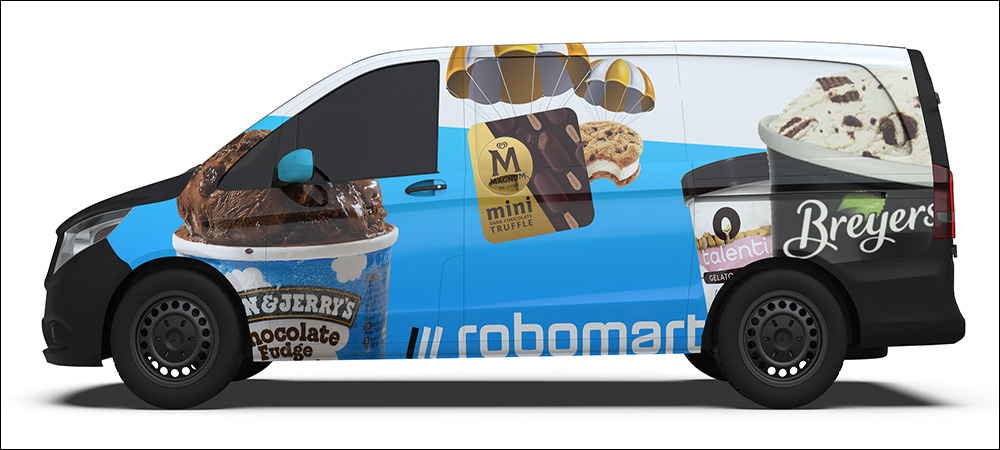- Hailing an Ice Cream Shop
- Tracking Purchases and Inventory via RFID
- The Benefits of RFID Over Computer Vision
Shopping convenience is gaining ground for ice cream lovers, thanks to a partnership between technology company Robomart and ice cream provider Unilever. With a solution set to go live this summer in Los Angeles, Calif., consumers with a sweet tooth can use an app to order a mobile store to come to them, loaded with inventory leveraging radio frequency identification technology. The store is a temperature-controlled van in which RFID-tagged products can be monitored in real time for inventory and purchasing data.
Known as the Ice Cream Shop, Unilever’s virtual storefront employs Robomart’s fleet of temperature-controlled vehicles, each filled with ice cream products. RFID readers and antennas built into the shelves of the vehicles track all products, based on the RFID tag attached to each item. Consumers can hail the mobile store and pay for goods using the Robomart app.
Robomart, launched in 2021, partnered with a brand to offer two types of mobile sales solutions, known as Snacks Robomart and Pharmacy Robomart. For the past year, the company has been providing limited versions of this technology to a variety of businesses in the pharmaceuticals and snack food sectors (see Driverless Mobile Store Leverages RFID to Bring Food to Customers and The Convenience Store that Visits You).
The response to beta testing has been impressive, says Ali Ahmed, Robomart’s cofounder and CEO. “We’ve seen a phenomenal response,” he says, with consumers hailing a store on wheels and completing their transactions within minutes. “Our fastest engagement, start to end, has been one minute 51 seconds,” he reports, though orders are typically completed within nine minutes, on average.

The store is a temperature-controlled van in which RFID-tagged products can be monitored in real time for inventory and purchasing data.
Hailing an Ice Cream Shop
Unilever is among the world’s largest consumer goods companies. It provides everyday products ranging from Dove soap to Axe men’s products, in addition to numerous ice cream brands. With its Ice Cream Shop enabling summer deliveries in the West Hollywood area of Los Angeles, the company will provide on-demand ice cream from Ben and Jerry’s, as well as the Breyers, Good Humor, Magnum and Talenti brands. To make a purchase, participants would first up download the Robomart app on their smartphone, then provide payment information that can be stored with their account.

Ali Ahmed
When users have a craving for ice cream, they can open the app, select “The Ice Cream Shop Robomart” and view the menu of products available. The GPS data from their phone is linked to their order to identify their location, and the request is transmitted to the nearest vehicle. The driver follows the mapping directions to the site, similarly to the way Lyft and Uber drivers find clients. When the vehicle pulls up in the customer’s vicinity, that person is alerted in the app and can select a prompt to open the store’s door. Once the door is open, the customer can select items from the products displayed.
Each product has an adhesive, passive UHF RFID tag attached to it, and the unique ID number encoded on the tag is linked to that item in Robomart’s software. Because of the relatively long read range of UHF RFID, as opposed to 13.56 MHz HF RFID (several meters, as opposed to centimeters), the system does not identify a selection from a customer until that person is finished and the door closes. When the shopper completes the selection, the door must close before the individual is charged. The system then “calculates your basket once the door closes,” Ahmed says.
There are several ways in which this can be accomplished. Shoppers can select the prompt in the app on their phone to close the door, which means they do not need to touch anything inside the van. They can also press a button on the side of the door to prompt its closing, or they can simply walk away. After a span of time, preset by the operator—two minutes, for example—the door will close again. Once that happens, the RFID readers interrogate all tags in the remaining inventory and identify what has been removed. The shopper is notified in the app regarding what has been purchased and is billed for those products. The driver can drive away, and Robomart sends a receipt.
Tracking Purchases and Inventory via RFID
The RFID technology provides inventory-management data so the mobile store’s products are never out of stock. If, for example, a customer removed the last of a specific ice cream flavor and brand, or if the minimum inventory level allowed in the software was met, the Robomart system would identify the need for replenishment. The technology also provides real-time data for shoppers. If a specific brand or flavor is temporarily out of stock, it is removed from the app’s menu so that the company can avoid disappointing shoppers who hail a mobile store looking for a specific product, only to find it unavailable.
In addition, Robomart provides stations in which the vehicles can be restocked in a neighboring area. When a van arrives at such a site, workers can automatically view what needs to be restocked even before opening the van, which makes the restocking process faster and more accurate. Once an RFID product is placed in the mobile store at the back of the vehicle, the RFID reader captures its tag ID. The item is thus updated into the van’s inventory data.
Ahmed declines to specify how many Ice Cream Shop mobile stores are in use throughout Los Angeles, though he says there are nearly 100 such stores booked for use around the United States to sell a variety of products. For instance, Robomart intends to expand its technology presence into groceries and other categories. In the long term, he reports, these vehicles could operate without a driver, though state regulations still demand drivers in most areas.
“We expect, in the future, to introduce driverless vehicles into our fleet as regulation allows,” Ahmed states. In the meantime, although the vehicles each have a driver, that employee does not interact with customers, but simply delivers the mobile store to them until they no longer need it. As the beta tests have taken place with snack and drugstore brands, he says, “We’ve seen consumers absolutely fall in love with the system. We’ve averaged 2.3 orders across our user base per week” during the beta stage, he reports, while some consumers are hailing at a rate of 10 times a week.
The system requires some time for consumers to acclimate. The company noted early into beta testing that shoppers had a tendency to reach for the door handle even after swiping in the app to unlock it. “They wouldn’t immediately realize it’s a complete touch-free experience,” Ahmed says. The solution, he adds, was simple: “We removed the handle.”
The RFID base data provides analytics and historical data, enabling companies to view in real time—or throughout the course of days and weeks—which products are purchased most frequently, and in which parts of a city or neighborhood, so that they can better stock their stores. “It’s been really enlightening to see which products do well,” Ahmed says.
The Benefits of RFID Over Computer Vision
Retailers typically pay a fee for the service, as well as a commission on sales. Merchants deliver the product to the Robomart station, and from that point forward, the technology company’s employees take care of all operations, which includes applying tags to products before stocking vehicles. The firm uses third-party technology providers for the RFID readers, antennas and tags, including Avery Dennison Smartrac and Zebra Technologies.
One technology alternative for managing inventory in the Ice Cream Shop vehicles could be computer vision systems. However, the store has opted for RFID based on the technology’s cost and accuracy. Camera-based systems typically provide only 60 to 70 percent reliability, the company has found.
“The reality is that you would need a human army to be manually checking video feeds to verify orders,” Ahmed states, “and with our RFID-based systems, not only are they extremely accurate, [but] fully automated. You do not need any humans to manually check, or just to verify them.” Robomart hopes to book more consumer brand companies and retailers in the future. “We’ve already exceeded our expectations for a number of bookings.”
Key Takeaways:
- Los Angeles consumers are using UHF RFID technology to hail a mobile store from Unilever, making ice cream purchases easier and more convenient than visiting stores.
- Robomart enables purchasing transactions, as well as inventory control and analytics, with the RFID technology.

